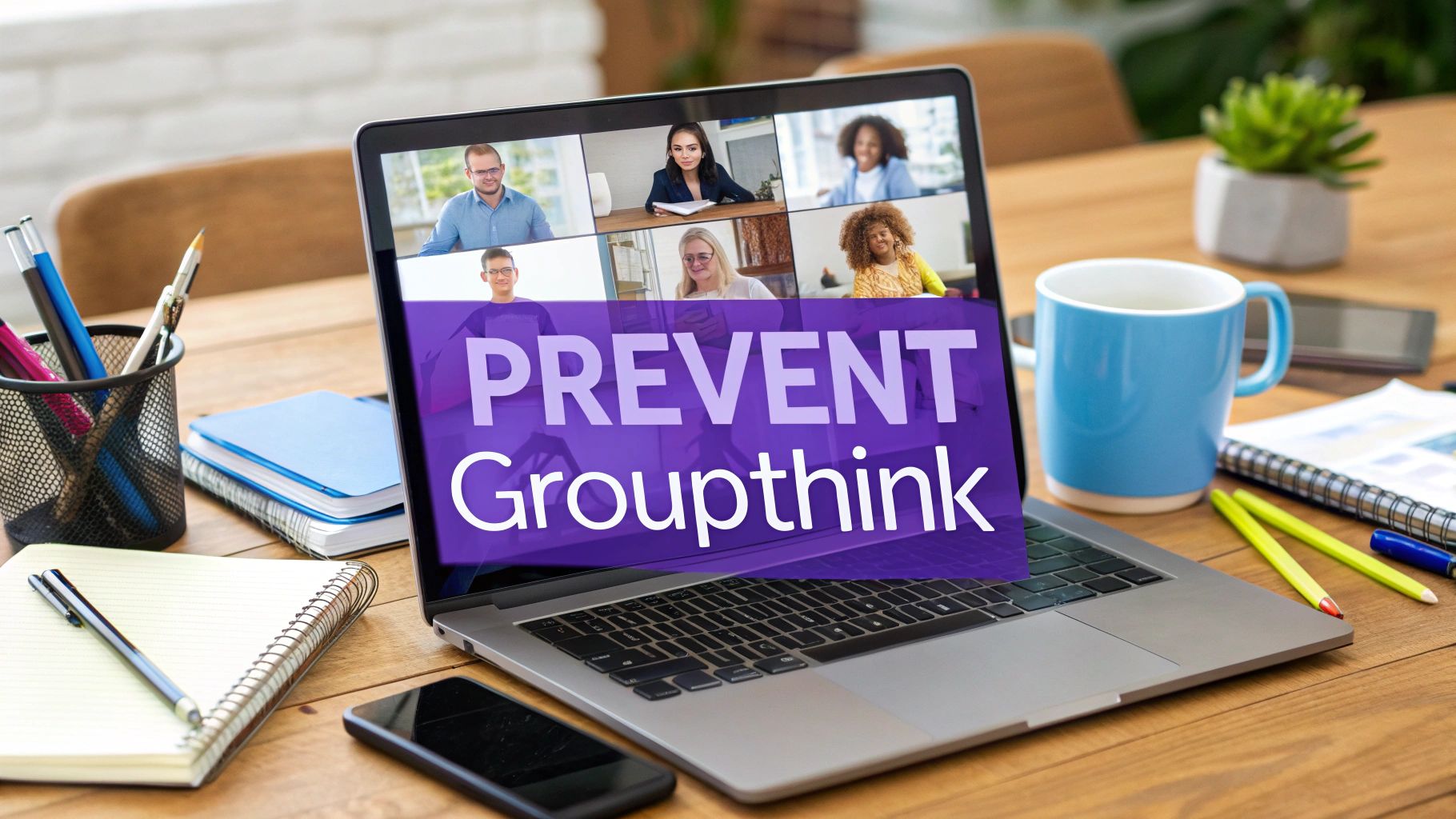Recognizing Groupthink Before It Costs You Everything
Have you ever been in a remote meeting where a big decision was made, and everyone agreed just a little too fast? That quiet, uncomfortable feeling you get when consensus feels more like pressure than genuine agreement is often the first whisper of groupthink. It's a sneaky psychological trap where the need for harmony within a team crushes any real evaluation of alternatives. Smart, capable people simply stop thinking for themselves and start conforming, which can lead to some truly terrible outcomes. When teams fall into this trap, they don't just make one bad call; they build a culture where poor decisions become the rule, not the exception.
The Subtle Symptoms of a Flawed Process
Spotting groupthink means you have to look past the surface-level agreement. The social psychologist who first coined the term, Irving Janis, pointed out several key symptoms. These aren't just abstract ideas; they show up in our day-to-day work. For instance, the illusion of invulnerability can cause a team to take wild risks because they honestly believe they can't fail. Another sign is self-censorship, where people bite their tongues and hold back dissenting views to avoid "rocking the boat"—a common reaction in high-pressure situations.
This chart shows just how quickly groupthink can creep in, but also highlights how putting preventative measures in place can boost the quality of decisions and the diversity of ideas.
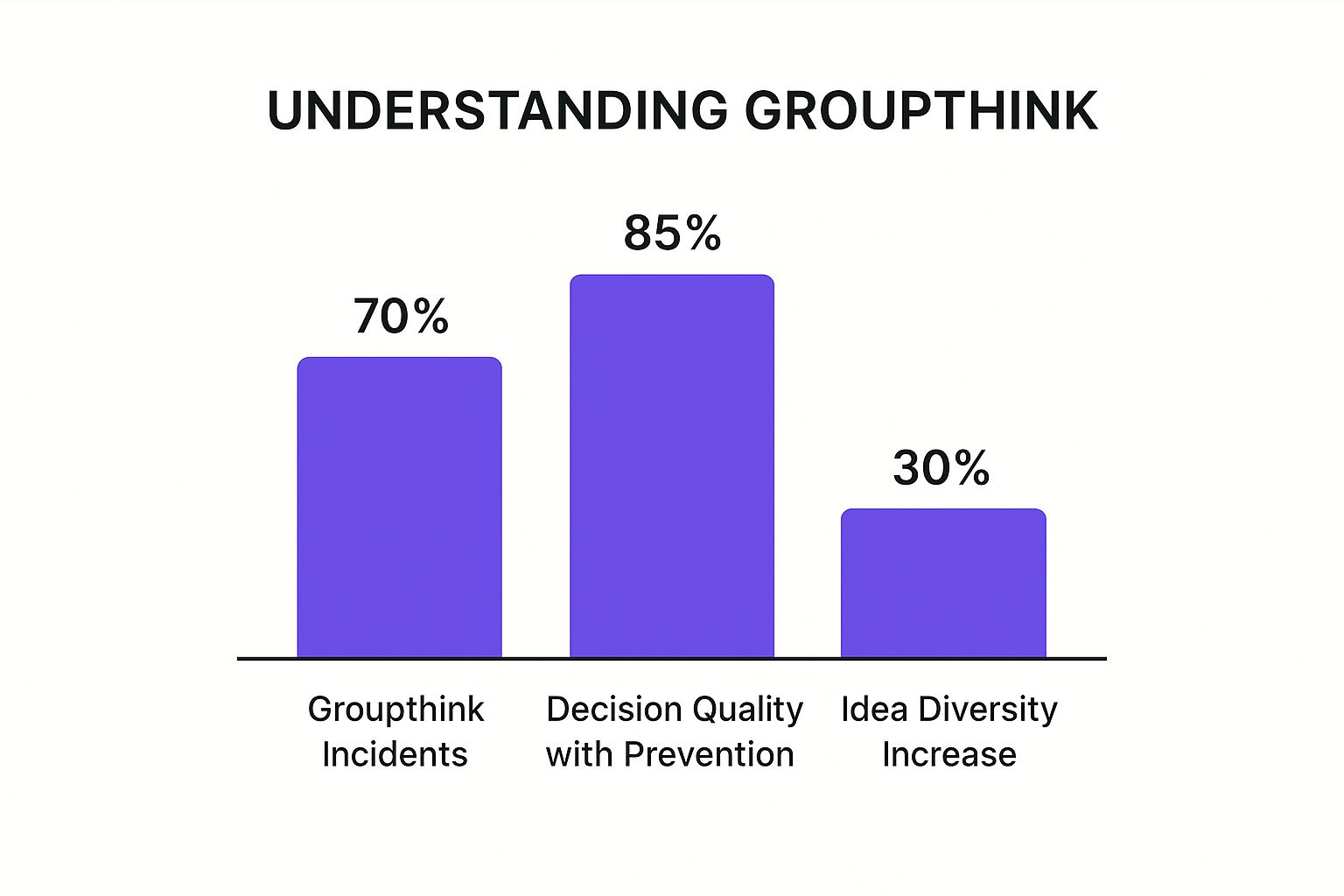
The data here is clear: while groupthink is a common problem, the right strategies can make a huge difference in decision outcomes and help cultivate a richer pool of ideas.
Warning Signs vs. Healthy Collaboration
It's so important to know the difference between a dangerous, forced consensus and a genuinely healthy alignment. A team that collaborates well will still have passionate debate and different points of view before landing on a final decision. A team that’s falling into groupthink, however, will show some very specific red flags.
To help you tell them apart, here's a quick comparison of what to look for.
Common Groupthink Warning Signs vs. Healthy Team Dynamics
A comparison showing the key differences between groupthink behaviors and productive team collaboration
| Groupthink Behaviors | Healthy Team Dynamics | Impact on Decisions |
|---|---|---|
| Pressure to conform and silence anyone who disagrees. | Dissent is encouraged as a way to stress-test ideas and find weaknesses. | Leads to poorly vetted, high-risk decisions. |
| Unquestioned belief in the team's morality or inherent rightness. | Ethical implications are openly discussed and debated from all angles. | Increases the risk of making unethical choices. |
| Ignoring clear warning signs and obvious risks. | Risks are actively sought out, and contingency plans are made. | Results in blind spots and a lack of preparedness for what might go wrong. |
These patterns aren't just theoretical. History is full of cautionary tales, from corporate disasters to national tragedies. The 1986 Challenger space shuttle disaster is a classic example. Engineers had serious concerns about launching in cold weather, but they were overruled by intense pressure to stick to the launch schedule, leading to a catastrophic failure. This Wikipedia entry on groupthink details even more historical cases where this phenomenon had devastating consequences.

The lesson from these events is crystal clear: a culture that punishes or ignores disagreement is setting itself up for failure. The real challenge for today's leaders, especially in remote environments, is to build processes that actively stop groupthink from ever taking root. The first step is learning to see the warning signs for what they are—not as indicators of a cohesive team, but as red flags signaling a deeply broken decision-making process.
Building Teams That Actually Challenge Each Other
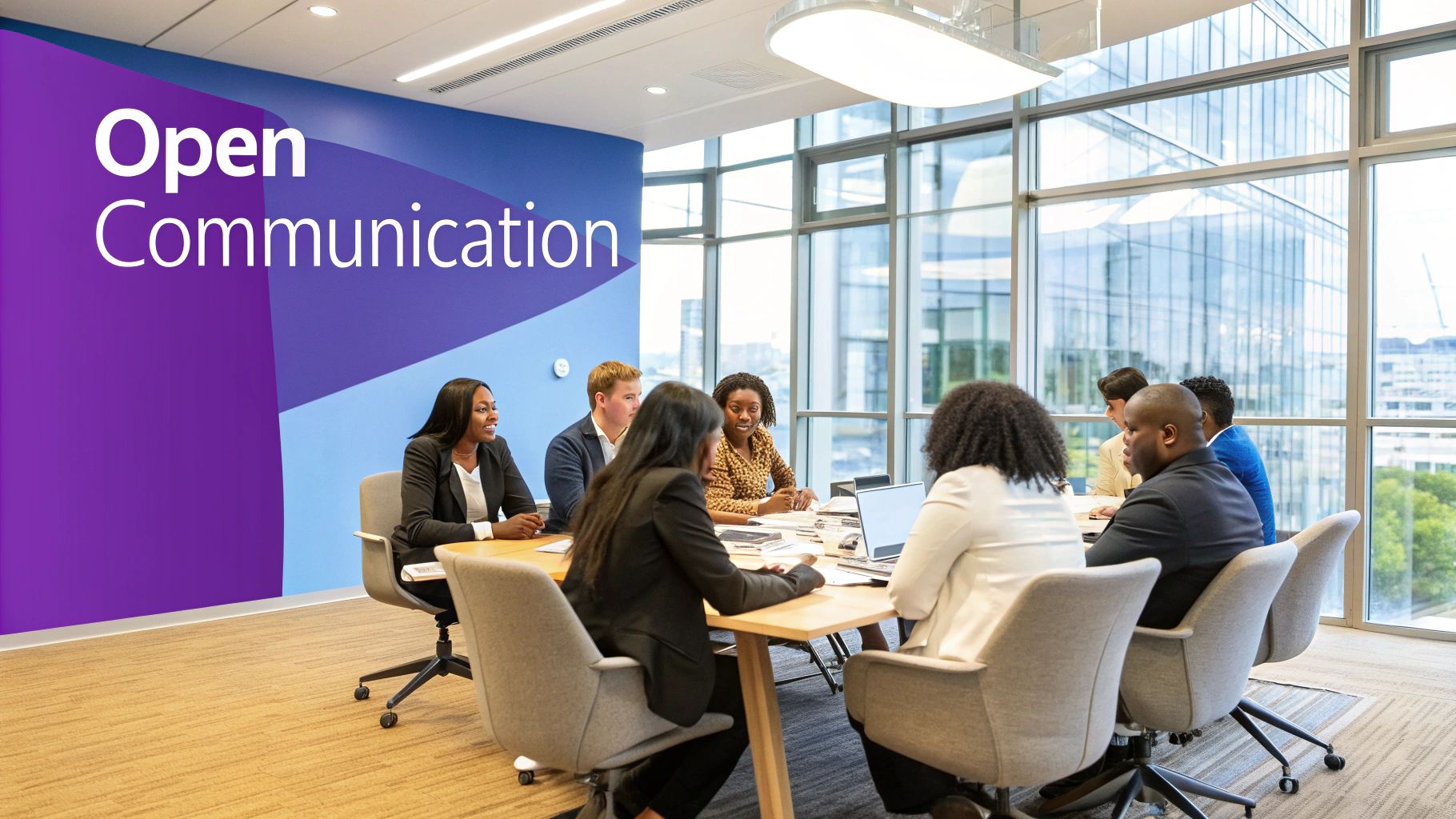
To get ahead of groupthink, you need to go deeper than just assembling a team that looks diverse on paper. The real secret sauce is building a team with cognitive diversity—one filled with people who genuinely think differently from one another. This means you need to intentionally look for individuals with various problem-solving styles, life experiences, and ways of looking at the world. When you make this a priority, you're not just satisfying a metric; you're creating a natural defense against the tendency to agree too quickly.
Many companies are starting to get this and are changing how they hire. Instead of just searching for a "culture fit," which often just means "people who think and act like us," they’re seeking a "culture add." This means asking tougher questions in interviews to see how a candidate really thinks. For instance, rather than asking them to solve a hypothetical problem, present a real, close-call decision your company made in the past. Then, ask them to argue against the choice you made. This shows you their ability to think critically and independently, not just their skill at picking the "right" answer.
Hiring for Healthy Friction
The aim isn't to hire people who will disagree just to be difficult. It's about finding those who aren’t afraid to speak up when something doesn’t feel right. This calls for specific interview tactics that can reveal a candidate's true thought process.
Here are a few approaches you can try:
- Present a Flawed Plan: Lay out a project idea that has a few subtle but critical flaws. See if the candidate catches the problems and raises concerns, or if they just nod along to be agreeable.
- Ask About a Past Disagreement: Ask the candidate to walk you through a time they disagreed with a team’s direction. Listen carefully to how they managed the situation. Did they shut down, get defensive, or find a constructive way to offer their alternative viewpoint?
- Use Behavioral Questions: Try questions like, "Tell me about a time you had to convince your team to see an issue from a completely different angle. What happened?"
These methods help you find people who bring constructive friction to the table—the kind of intellectual debate that makes ideas stronger. This is a big part of what we discuss in our guide on creative problem-solving techniques, where different perspectives are the key to better outcomes. The numbers back this up, too. Research shows that teams with high diversity scores are 35% more likely to spot problems early and 25% more likely to come up with inventive solutions. You can learn more about how diversity fights groupthink in this insightful workplace analysis.
Creating Safe Spaces for Productive Disagreement
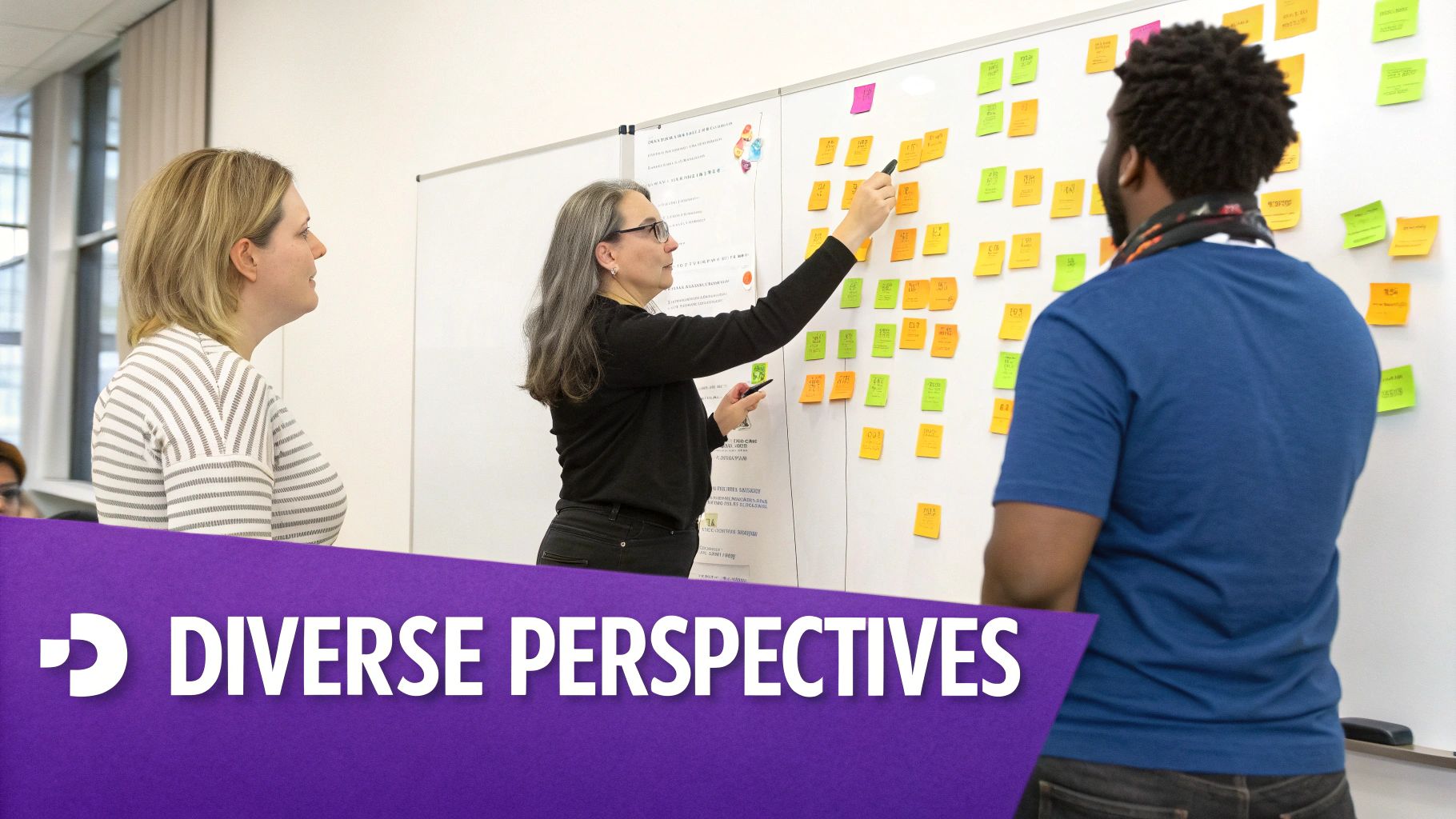
The secret to breaking down groupthink isn’t just about having a diverse team; it’s about making sure every person feels safe enough to speak their mind. This brings us to a crucial concept: psychological safety. It's that shared feeling on a team that you won't be punished or humiliated for admitting a mistake or, more importantly, for disagreeing with the group.
Without it, even your most creative and independent thinkers will bite their tongues to avoid rocking the boat. So, how do you actually build this? It all starts with intentional leadership and setting clear ground rules for communication.
One of the most effective things a leader can do is model vulnerability. When you openly say, "I might be off track here, what am I missing?" you immediately give your team permission to challenge ideas—even yours. This simple phrase shifts the entire dynamic from a one-way presentation to a genuine problem-solving conversation. For anyone leading a remote team, there are specific strategies for building trust in virtual teams that truly work. This trust is the bedrock of all productive disagreement.
To help leaders put this into practice, here is a framework that outlines concrete actions and their expected results.
| Leadership Action | Implementation Method | Expected Outcome | Timeline |
|---|---|---|---|
| Model Vulnerability | Openly admit mistakes or knowledge gaps in meetings. Ask questions like, "What's a different way to look at this?" | Team members feel more comfortable admitting their own uncertainties and are more likely to offer dissenting opinions. | Immediate, ongoing |
| Establish "Disagree and Commit" Principle | During decision-making, explicitly state that debate is encouraged, but once a decision is made, everyone commits to the path forward. | Reduces fear of permanent conflict and encourages robust discussion without fear of personal repercussions. | Within the first month |
| Actively Solicit Dissenting Views | In meetings, specifically ask, "Who has a different perspective?" or "What are the potential downsides to this idea?" | Normalizes disagreement as part of the process, ensuring alternative viewpoints are heard before a consensus is reached. | Ongoing, in every key meeting |
| Implement Anonymous Feedback Channels | Use tools like Bulby for anonymous idea submission during brainstorming sessions. | Ideas are judged on merit, not on who suggested them. Quieter team members contribute more freely. | Within the first 2 weeks |
| Respond Productively to Challenges | When an idea is challenged, thank the person for their input and engage with the substance of their critique, rather than becoming defensive. | Reinforces that challenging the status quo is valued and safe, encouraging more of it in the future. | Immediate, ongoing |
This table shows that building psychological safety is an active, continuous process. By taking these steps, leaders can create a culture where team members feel genuinely empowered to contribute their best, most honest thinking.
Practical Steps for Safer Meetings
Creating this environment isn't just about good intentions; it requires putting the right structures in place. In any meeting, it's easy for a few dominant voices to take over, leaving quieter thinkers in the background. To fight off groupthink, you need to intentionally redesign the flow of conversation.
Here are a few practical methods to make sure every voice is heard:
- The Silent Start: Before jumping into a discussion, give everyone five minutes to write down their thoughts on the topic. This technique, sometimes called "brainwriting," ensures that initial ideas aren't colored by the first or loudest person to speak.
- Structured Go-Arounds: Instead of a free-for-all discussion, go around the virtual room one by one and ask each person to share a key thought. This guarantees that even the most introverted team members have dedicated time to speak without having to interrupt.
- Anonymous Feedback Tools: Use platforms that allow for anonymous idea submissions. Bulby’s brainstorming features are great for this, as they let team members post ideas without their names attached, shifting the focus to the quality of the idea itself.
These aren't just quick meeting tricks; they are structural changes that signal to your team that their individual perspectives are valued and respected. You can find more structured approaches in our guide to creative thinking exercises for teams. Ultimately, preventing groupthink is about fostering a culture where constructive conflict is not just accepted but actively encouraged as a key part of making great decisions.
Beyond Devil's Advocate: Smart Ways to Encourage Dissent
When managers look for ways to prevent groupthink, they often reach for a familiar tool: assigning a devil’s advocate. The idea makes sense on the surface—you force the team to look at the other side. But this approach usually backfires. When everyone knows someone is supposed to disagree, their points are easy to brush off. It feels like they're just playing a part, which creates fake opposition instead of the genuine, critical thinking you're after.
Real dissent isn't about fulfilling a role; it comes from an authentic concern or a genuinely different viewpoint. Instead of appointing a token dissenter, the best leaders build systems that let real concerns come to light naturally. This means going beyond one-off tactics and embedding healthy skepticism right into your team’s daily workflow.
Structuring Authentic Disagreement
A much better way to encourage honest feedback is to structure meetings so independent thought is protected before the group's influence kicks in. One great method for this is brainwriting. Before anyone says a word, have each person silently spend a few minutes writing down their ideas and potential worries about a proposal.
This screenshot from a Harvard Business Review article shows why old-school brainstorming often lets a few loud voices dominate the whole discussion.
This really drives home the point that giving people uninterrupted time to think on their own is crucial for getting a wider and more honest range of ideas. After the silent writing time, you can collect the ideas anonymously using a tool like Bulby or have everyone share in a structured, round-robin style. This simple change makes a huge difference:
- It levels the playing field, giving introverted or junior team members the same platform as everyone else.
- It stops the first person who speaks from setting the tone for the entire conversation.
- It brings genuine disagreements to the surface because people have had a moment to think about what really concerns them.
This process turns disagreement into a valuable part of making a decision, rather than making it feel like a confrontation. Instead of one person playing a role, the whole team gets involved in spotting potential problems. This leads to a much stronger and more carefully considered outcome and is how you truly build critical thinking into your team's culture.
How Employee Wellness Prevents Groupthink
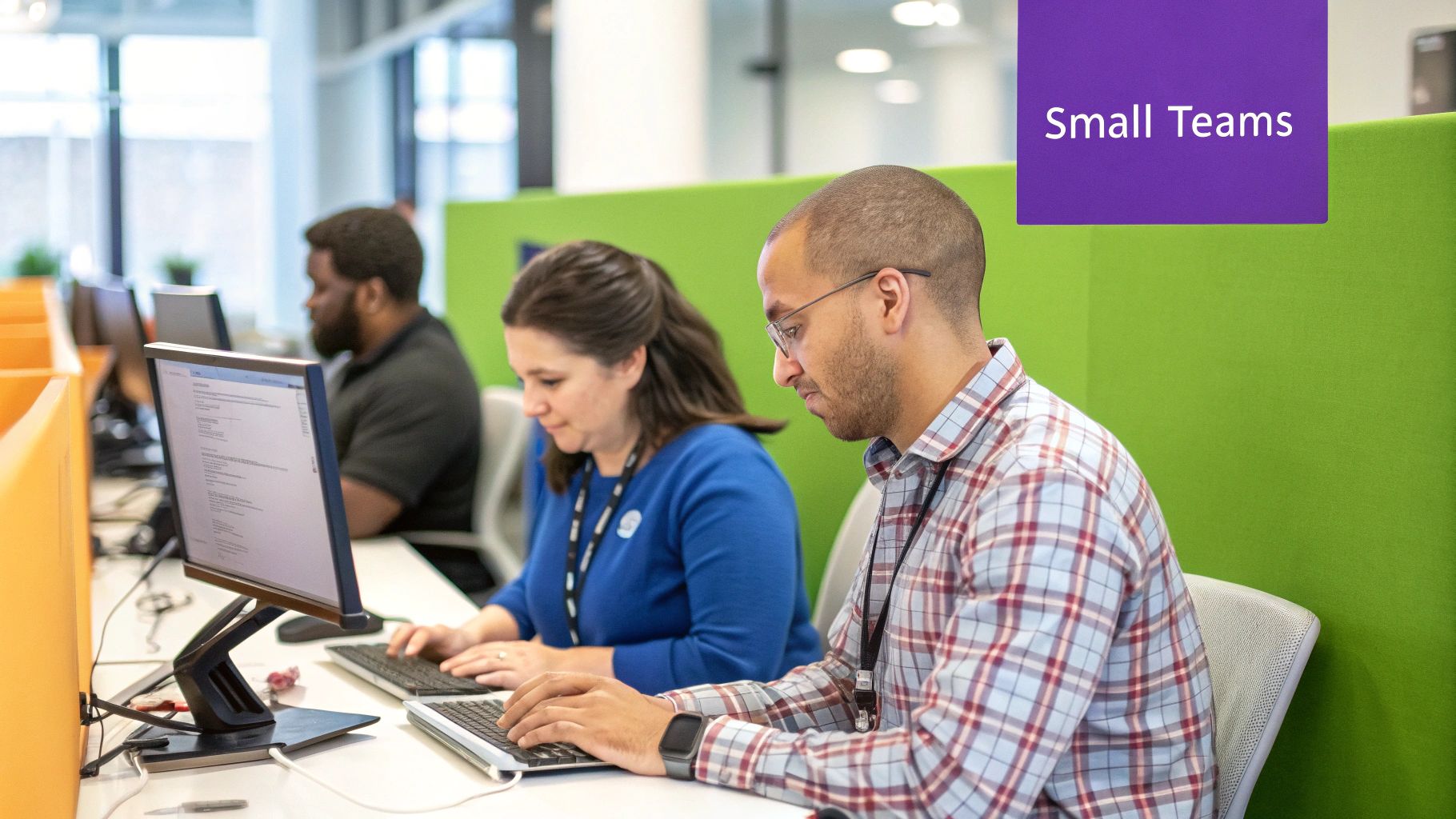
Here’s a connection many leaders miss when trying to figure out how to prevent groupthink: tired, stressed employees tend to just agree. Thinking independently, questioning assumptions, and offering a different point of view all take serious mental energy. When people are running on fumes, they are much more likely to take the path of least resistance and just go with the flow. The effort needed for real critical thinking feels like a mountain they’re too exhausted to climb.
This is where employee wellness becomes a surprisingly effective strategic tool. It's not just about gym memberships; it’s about creating an environment where people have the mental and emotional reserves to engage deeply. A key part of this is focusing on strategies for preventing employee burnout. When you tackle burnout head-on, you give people back the cognitive resources they need for high-quality decision-making.
The Link Between Well-Being and Independent Thought
Think of your team's cognitive energy like a phone battery. Every stressful meeting, every tight deadline, and every long day drains it. A well-designed wellness program acts as a charging station, making sure your team isn’t constantly operating in the red.
This isn't just a nice idea; the data shows a clear link between well-being and sharper thinking. Research from Wellhub shows that companies with strong wellness programs see better employee focus and executive function. The findings also reveal that 65% of employees at these companies feel more confident expressing different opinions, and 72% report being more engaged in decision-making. When you invest in your team’s health, you’re also investing in their courage to think for themselves.
Practical Wellness Strategies That Boost Brainpower
To see real change, you need to go beyond generic perks and offer programs that directly support mental clarity and resilience. Here are a few practical ideas to get you started:
- Promote "Deep Work" Blocks: Encourage everyone to schedule chunks of time for focused, uninterrupted work. This cuts down on the mental drain from constantly switching between tasks.
- Offer Mental Health Resources: Provide easy access to counseling services or mindfulness apps. This gives people the tools to manage stress before it snowballs into burnout.
- Encourage PTO for Real Breaks: As a leader, you have to model this one. Take real time off—no checking emails, no "quick" calls. This shows the entire team that it's okay to truly disconnect and recharge.
By prioritizing employee well-being, you’re doing more than just being a good employer. You are strategically creating the foundation for independent thought and building a stronger, more natural defense against groupthink.
Decision-Making Systems That Force Independent Thinking
Good intentions alone won't stop groupthink. The most reliable way to prevent it is by baking safeguards directly into your team’s processes. When you design decision-making systems that require independent thought, you systematically take apart the pressures that lead to a quick and easy consensus. This isn’t about making meetings longer or more complex; it’s about making them smarter. The goal is to surface diverse perspectives before the group’s influence can take over.
The idea is to get everyone's individual thoughts on the table before they can be swayed by the first person who speaks or the most senior person in the room. This approach moves beyond simply asking for different opinions and instead creates a structure where they are a required part of the process.
Structuring Meetings for Independent Input
One of the most effective and simple techniques for this is called brainwriting. Instead of kicking off a meeting with an open, free-for-all discussion, you start with a period of silence. Everyone gets five to ten minutes to independently write down their ideas, concerns, and questions about the topic at hand.
This screenshot from MindTools shows the basic idea of brainstorming, but brainwriting adds a crucial first step: a silent, independent phase.
This quiet time is essential because it ensures everyone's initial thoughts are genuinely their own, not colored by the group's dynamic. Only after this independent work are the ideas shared, often anonymously. You can use a tool like Bulby’s brainstorming features to collect these notes without names attached. This way, the team evaluates the idea on its own merit, not based on who suggested it. This small structural change is a powerful way to prevent groupthink because it guarantees a wider range of initial thoughts from the very beginning.
Advanced Protocols for Better Choices
For bigger, more impactful decisions, you might want to use a multi-stage process. For example, a team could first meet just to define the problem and gather evidence, without proposing any solutions. In a second session, they could brainstorm solutions independently (using the brainwriting technique). Finally, in a third meeting, they come together to debate the anonymously submitted options.
This separation gives ideas room to breathe and be judged fairly. You can find more structured methods in this guide to collaborative decision-making. By building these checks into your workflow, you create a system where critical, independent thinking isn't just encouraged—it's required.
Measuring Success: Know When Your Strategies Are Working
Putting new strategies in place to fight groupthink is a great first move, but how do you know if they're actually making a difference? Without a way to measure your progress, even the best intentions can fall flat. Moving beyond a "gut feeling" means you need to track specific signals—both the numbers you can count and the cultural shifts you can see. This isn't about creating more work; it's about getting real insight into whether your team is genuinely thinking more independently.
A solid starting point is to look at the diversity of ideas coming out of your meetings. Before you tried these new approaches, your brainstorming sessions might have produced a small handful of similar-sounding suggestions. After using techniques like silent brainwriting or anonymous feedback tools, are you seeing a wider range of truly different concepts? This increase in idea diversity is a powerful quantitative metric. You can literally count the number of unique proposals to see if your efforts are paying off.
Qualitative Clues and Long-Term Tracking
Beyond the hard numbers, it's crucial to pay attention to the subtle, qualitative shifts in how your team interacts. These cultural changes are often the most meaningful signs that you are successfully learning how to prevent groupthink.
Here are a few key things to watch for:
- Meeting Dynamics: Do team members now challenge each other's ideas openly and respectfully? Is there more healthy debate before a decision is made, rather than everyone just nodding along?
- Feedback Patterns: Are junior team members or your quieter folks speaking up more often? When someone does offer a dissenting opinion, watch the group's reaction closely. Is that person thanked for their perspective, or are they met with awkward silence? A positive reception is a huge win.
- Decision Outcomes: Over time, track the results of decisions made with these new methods. Are you catching potential problems earlier in the process? Are your projects hitting fewer unexpected bumps in the road? Looking back at past decisions can show clear patterns of improved critical thinking.
By combining these quantitative and qualitative measures, you get a full picture of your team's health. You'll not only see when your strategies are working but also spot areas where you might need to make adjustments for even better results.
Ready to give your team the structure they need for better, more independent thinking? Discover how Bulby guides your team through structured brainstorming exercises that ensure every voice is heard and every idea gets a fair shot.

